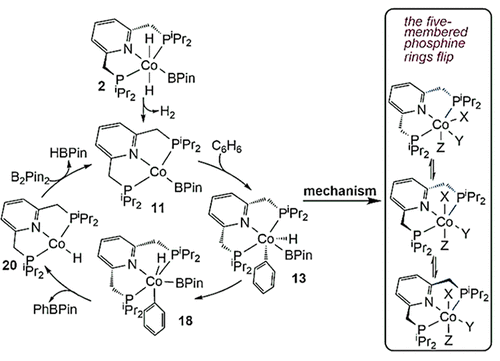当前位置:
X-MOL 学术
›
ACS Catal.
›
论文详情
Our official English website, www.x-mol.net, welcomes your
feedback! (Note: you will need to create a separate account there.)
Cobalt Pincer Complexes in Catalytic C–H Borylation: The Pincer Ligand Flips Rather Than Dearomatizes
ACS Catalysis ( IF 11.3 ) Pub Date : 2018-10-17 00:00:00 , DOI: 10.1021/acscatal.8b03146 Haixia Li 1 , Jennifer V. Obligacion 2 , Paul J. Chirik 2 , Michael B. Hall 1
ACS Catalysis ( IF 11.3 ) Pub Date : 2018-10-17 00:00:00 , DOI: 10.1021/acscatal.8b03146 Haixia Li 1 , Jennifer V. Obligacion 2 , Paul J. Chirik 2 , Michael B. Hall 1
Affiliation

|
The mechanism for the borylation of an aromatic substrate by a cobalt pincer complex was investigated by density functional theory calculations. Experimental observations identified trans-(iPrPNP)CoH2(BPin) as the resting state in the borylation of five-membered heteroarenes and 4-BPin-(iPrPNP)Co(N2)BPin as the resting state in the catalytic borylation of arene substrates. The active species, 4-R-(iPrPNP)CoBPin (R = H, BPin), were generated by reductive elimination of H2 in the former, through Berry pseudorotation to the cis isomer and N2 loss in the latter. The catalytic mechanism of the resulting Co(I) complex was computed to involve three main steps: C–H oxidative addition of the aromatic substrate (C6H6), reductive elimination of PhBPin, and regeneration of the active complex. The oxidative addition product formed through the most favorable pathway, where the breaking C–H bond of C6H6 is parallel to a line between the two phosphine atoms, leaves the complex with a distorted PNP ligand, which rearranges to a more stable complex via dissociation and reassociation of HBPin. Alternative pathways, σ-bond metathesis, and the oxidative addition in which the breaking C–H bond is parallel to the Co–B bond are predicted to be unlikely for this Co(I) complex. The thermodynamically favorable formation of the product PhBPin via reductive elimination drives the reaction forward. The active species regenerates through the oxidative addition of B2Pin2 and reductive elimination of HBPin. In the overall reaction, the flipping (refolding) of the five-membered phosphine rings, which connects the species with two phosphine rings folded in the same direction and that with them folded in different directions, is found to play an important role in the catalytic process, as it relieves steric crowding within the PNP ligand and opens Co coordination space. Metal–ligand cooperation based on the ligand’s aromatization/dearomatization, a common mechanism for heavy-metal pincer complexes, and the dissociation of one phosphine ligand do not apply in this system. This study provides guidance for understanding important features of pincer ligands with first-transition-row metals that differ from those in heavier metal complexes.
中文翻译:

催化CH硼化中的钴钳配合物:钳配合物比脱芳基化更容易发生翻转
通过密度泛函理论计算研究了钴夹钳配合物对芳香族底物进行硼化的机理。实验观察结果表明,反式-(iPr PNP)CoH 2(BPin)在五元杂芳基的硼酸酯化中处于静止状态,而4-BPin-((iPr PNP)Co(N 2)BPin在三元芳烃的催化硼化中处于静止状态。芳烃底物。活性物质4-R-(iPr PNP)CoBPin(R = H,BPin)是通过还原消除前者中的H 2,通过将Berry假旋转为顺式异构体和N 2而产生的后者的损失。计算得出的Co(I)配合物的催化机理涉及三个主要步骤:芳香族底物(C 6 H 6)的C–H氧化加成,PhBPin的还原消除和活性配合物的再生。氧化加成产物通过最有利的途径形成,其中C 6 H 6的C–H断裂键平行于两个膦原子之间的线,使复合物带有扭曲的PNP配体,该配体通过HBPin的解离和重新结合重排为更稳定的复合物。对于这种Co(I)络合物,不太可能选择其他途径,σ键易位和氧化加成,其中C–H断裂键与Co–B键平行。经由还原消除的产物PhBPin的热力学上有利的形成将反应向前推进。活性物质通过B 2 Pin 2的氧化添加和HBPin的还原消除而再生。在整个反应中,发现五元膦环的翻转(重折叠)将物种与两个沿相同方向折叠的膦环连接以及将其沿不同方向折叠的膦环连接,在催化过程中起着重要作用。过程,因为它可以缓解PNP配体内的空间拥挤并打开Co配位空间。基于配体的芳构化/脱芳构作用的金属-配体合作,重金属钳位复合物的常见机理以及一种膦配体的离解不适用于该系统。这项研究为理解具有不同于重金属配合物的第一过渡行金属的钳型配体的重要特征提供了指导。
更新日期:2018-10-17
中文翻译:

催化CH硼化中的钴钳配合物:钳配合物比脱芳基化更容易发生翻转
通过密度泛函理论计算研究了钴夹钳配合物对芳香族底物进行硼化的机理。实验观察结果表明,反式-(iPr PNP)CoH 2(BPin)在五元杂芳基的硼酸酯化中处于静止状态,而4-BPin-((iPr PNP)Co(N 2)BPin在三元芳烃的催化硼化中处于静止状态。芳烃底物。活性物质4-R-(iPr PNP)CoBPin(R = H,BPin)是通过还原消除前者中的H 2,通过将Berry假旋转为顺式异构体和N 2而产生的后者的损失。计算得出的Co(I)配合物的催化机理涉及三个主要步骤:芳香族底物(C 6 H 6)的C–H氧化加成,PhBPin的还原消除和活性配合物的再生。氧化加成产物通过最有利的途径形成,其中C 6 H 6的C–H断裂键平行于两个膦原子之间的线,使复合物带有扭曲的PNP配体,该配体通过HBPin的解离和重新结合重排为更稳定的复合物。对于这种Co(I)络合物,不太可能选择其他途径,σ键易位和氧化加成,其中C–H断裂键与Co–B键平行。经由还原消除的产物PhBPin的热力学上有利的形成将反应向前推进。活性物质通过B 2 Pin 2的氧化添加和HBPin的还原消除而再生。在整个反应中,发现五元膦环的翻转(重折叠)将物种与两个沿相同方向折叠的膦环连接以及将其沿不同方向折叠的膦环连接,在催化过程中起着重要作用。过程,因为它可以缓解PNP配体内的空间拥挤并打开Co配位空间。基于配体的芳构化/脱芳构作用的金属-配体合作,重金属钳位复合物的常见机理以及一种膦配体的离解不适用于该系统。这项研究为理解具有不同于重金属配合物的第一过渡行金属的钳型配体的重要特征提供了指导。











































 京公网安备 11010802027423号
京公网安备 11010802027423号